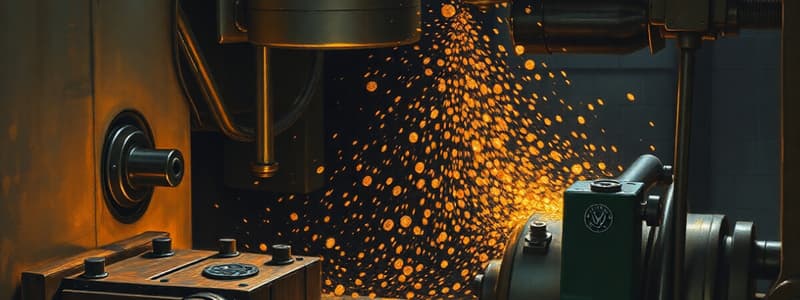Podcast
Questions and Answers
What impact does the coolant system have on cutting forces during machining?
What impact does the coolant system have on cutting forces during machining?
- Coolant systems do not affect cutting forces.
- Adhesion on the tool is lowest with dry cutting conditions.
- The flooded coolant system results in the lowest cutting forces. (correct)
- Cutting forces are highest under flooded coolant conditions.
What was observed regarding material adhesion during dry cutting at increased speeds?
What was observed regarding material adhesion during dry cutting at increased speeds?
- Adhesion had the highest rate. (correct)
- Adhesion remained constant.
- Adhesion varied with the type of tool used.
- Adhesion decreased significantly.
Which of the following describes the relationship between cutting speed and resultant cutting forces?
Which of the following describes the relationship between cutting speed and resultant cutting forces?
- Resultant forces tend to increase as cutting speed is raised. (correct)
- Cutting speeds do not affect tool wear.
- Cutting forces are independent of machining environments.
- Higher cutting speeds always result in lower cutting forces.
How does the application of flooded coolant compare to dry cutting in terms of material adhesion?
How does the application of flooded coolant compare to dry cutting in terms of material adhesion?
What characteristic of flank wear is primarily affected by the adhesion of the work material on the tool?
What characteristic of flank wear is primarily affected by the adhesion of the work material on the tool?
Which statement accurately reflects the surface roughness of the machined work-piece?
Which statement accurately reflects the surface roughness of the machined work-piece?
What is the effect of increasing cutting speed from 250 to 400 m/min on the surface roughness of the machined surface?
What is the effect of increasing cutting speed from 250 to 400 m/min on the surface roughness of the machined surface?
What is the impact of machining with MQL in terms of adhered material compared to flooded coolant?
What is the impact of machining with MQL in terms of adhered material compared to flooded coolant?
What factor associated with MQL (Minimum Quantity Lubrication) method requires further investigation?
What factor associated with MQL (Minimum Quantity Lubrication) method requires further investigation?
In terms of tool wear characteristics, which tool surface showed the highest rate of material adhesion?
In terms of tool wear characteristics, which tool surface showed the highest rate of material adhesion?
What machining parameters were fixed during the experiments conducted with the lathe?
What machining parameters were fixed during the experiments conducted with the lathe?
What is the relationship between cutting speed and thermal softening of the chip?
What is the relationship between cutting speed and thermal softening of the chip?
What angle was utilized for the positive rake angle of the tool?
What angle was utilized for the positive rake angle of the tool?
What is the primary coolant environment compared to MQL in the study?
What is the primary coolant environment compared to MQL in the study?
How does MQL with rapeseed oil perform under light-loaded machining conditions?
How does MQL with rapeseed oil perform under light-loaded machining conditions?
What tool wear measurement method was used during the machining tests?
What tool wear measurement method was used during the machining tests?
What is the maximum cutting speed tested in the experiments?
What is the maximum cutting speed tested in the experiments?
What criterion was used to evaluate surface finish in this study?
What criterion was used to evaluate surface finish in this study?
What effect does a lower cutting speed generally have on tool wear?
What effect does a lower cutting speed generally have on tool wear?
What was the primary focus of the study regarding the coolant environment?
What was the primary focus of the study regarding the coolant environment?
Which coolant rate was not tested in the MQL method during the experiments?
Which coolant rate was not tested in the MQL method during the experiments?
What tool geometry was used in the machining tests?
What tool geometry was used in the machining tests?
What device was used to measure on-line cutting forces during the machining tests?
What device was used to measure on-line cutting forces during the machining tests?
What was the effect of increasing the quantity of lubricant from 50 ml/h to 100 ml/h on material adherence during MQL conditions?
What was the effect of increasing the quantity of lubricant from 50 ml/h to 100 ml/h on material adherence during MQL conditions?
How does cutting speed influence flank wear when machining 6061 aluminum alloy?
How does cutting speed influence flank wear when machining 6061 aluminum alloy?
What conclusion can be drawn regarding the impact of coolant application on flank tool wear at MQL conditions?
What conclusion can be drawn regarding the impact of coolant application on flank tool wear at MQL conditions?
Which factor was found to influence the amount of material adhesion on the tool surface?
Which factor was found to influence the amount of material adhesion on the tool surface?
What modification can help reduce adhered material during machining under MQL conditions?
What modification can help reduce adhered material during machining under MQL conditions?
What was observed about the wear land width when comparing MQL and flooded coolant applications?
What was observed about the wear land width when comparing MQL and flooded coolant applications?
Why is the application of coolant considered to have economic advantages in machining?
Why is the application of coolant considered to have economic advantages in machining?
What was the relationship between tool wear and the quantity of coolant in MQL conditions?
What was the relationship between tool wear and the quantity of coolant in MQL conditions?
What was the impact of different types of coolant on tool wear in the studied machining conditions?
What was the impact of different types of coolant on tool wear in the studied machining conditions?
How does increasing the oil flow rate impact surface roughness during MQL?
How does increasing the oil flow rate impact surface roughness during MQL?
Flashcards are hidden until you start studying
Study Notes
Coolant Environment and Machining
- Tool inserts used in the experiments are ISO designation CNGA 120408 T01020 WG, with a positive rake angle of 15°, clearance angle of 7°, and nose radius of 0.8 mm.
- The tool holder used has ISO designation STG CL2020K16.
- Machining tests were performed on 6061 aluminum alloys with a high rigidity lathe, Kingsbury50 CNC, at speeds ranging from 50 to 400 m/min.
- Depth of cut and feed rate were fixed at 1.0 mm and 0.15 mm/rev, respectively.
Tool Wear
- During dry cutting, the adhesion of the work material to the tool was found to be highest, with material adhering to flank, rake, and clearance surfaces.
- Increased cutting speed from 250 to 400 m/min resulted in a significant increase in adhesion.
- Applying flooded coolant significantly reduced material adhesion compared to dry cutting.
- MQL (minimum quantity lubrication) machining had a level of material adhesion higher than flooded coolant but less compared to dry machining.
- The amount of material adhered during MQL was not significantly reduced when increasing the lubricant quantity from 50 ml/h to 100 ml/h.
- Tool wear was found to be lower under MQL conditions, but the amount of coolant determines material adhesion on the tool surface.
Cutting Forces
- Under dry cutting conditions, resultant cutting force was the highest due to material adhesion to the tool.
- Cutting forces were seen to increase as adhesion progressed on the tool.
- Flooded coolant resulted in the lowest resultant force due to reduced adhesion and friction.
- MQL conditions also reduced frictional forces, but further investigation on the coolant constituents is necessary to achieve even lower force levels comparable to flooded systems.
Machined Surface Quality
- Surface roughness (Ra) values were measured parallel to the feed direction.
- The application of coolant improved surface roughness at all cutting speeds.
- Higher cutting speeds (400 m/min) did not show a significant difference in surface roughness with different coolant quantities.
- MQL conditions have the potential to reduce surface roughness at higher speeds.
MQL Technology
- MQL with rapeseed oil showed a small lubricating effect in light loading conditions.
- MQL with water droplets presented better lubrication performance in the same conditions.
- MQL offers potential economic advantages in machining, as it can achieve results comparable to flooded lubrication conditions.
- Further research on tool geometry, coolant constituents, machine reliability, and other factors is necessary for wider adoption of MQL technology.
Studying That Suits You
Use AI to generate personalized quizzes and flashcards to suit your learning preferences.




